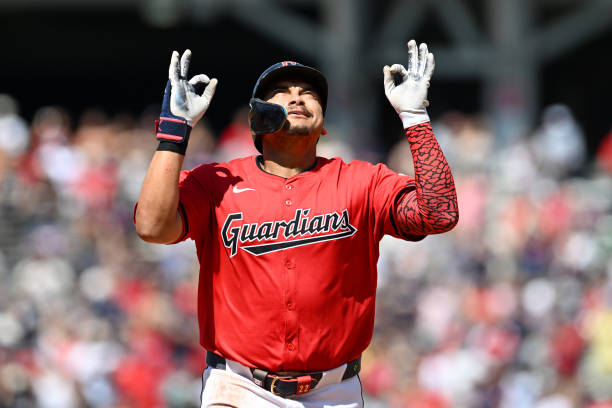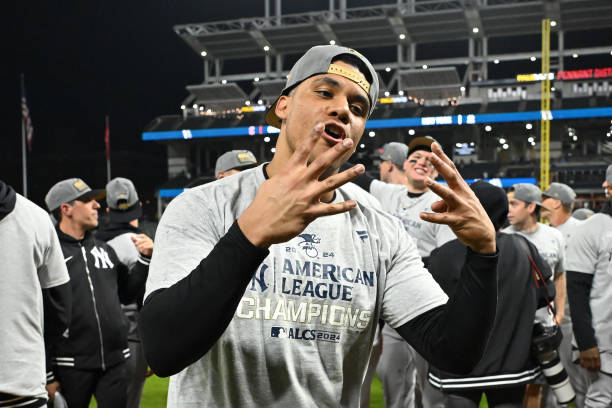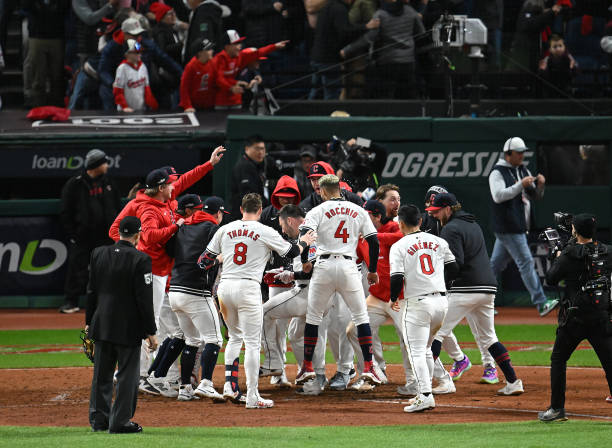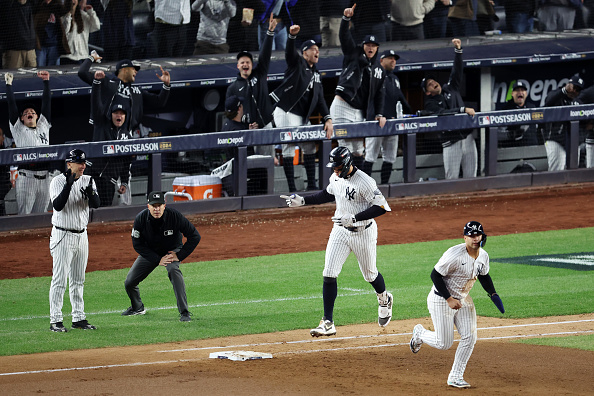GOODYEAR, Az. — It all starts with pitching for the Cleveland Guardians in 2023. No surprise. Preeminent pitchers are a proud franchise tradition in Cleveland– the town has had many maestros of the mound.
It was true on the way to winning the AL Central last year as staff ace Shane Bieber (13-8, 2.88 ERA), Cal Quantrill (15-5, 3.38 ERA), and Triston McKenzie (11-11, 2.96 ERA) led the way. The club hopes Aaron Civale (5-6) and Zach Plesac (3-12) will rebound from injury-marred seasons to once again give the Guardians a strong quintet. Two years ago, Civale went 12-5 and Plesac 10-6.
Embed from Getty Images
In 2020, Bieber became the fifth Cleveland starter to win the AL Cy Young Award, joining Gaylord Perry (1972), C.C. Sabathia (2007), Cliff Lee (2008) and Corey Kluber (2014 & 2017).
Current fans may be surprised to discover that well before any of them were born, Cleveland became famous for producing plenty of pitchers with extraordinary talent. When Kluber went 20-7 in 2018 (finishing third in Cy Young voting) it was the 57th time a Cleveland pitcher had 20 or more wins in a season.
Cleveland’s Cy Young Reward
The tradition began when an Ohio farmboy came to Cleveland in 1890. The city’s ball club was known as the Spiders, played in the National League, and were amidst a pitiful 44-88 record for a seventh-place finish when Denton True (Cy) Young joined them. The 23-year-old rookie compiled the staff’s only winning record at 9-7. That was far better than the club’s “ace”, the appropriately named Ed Beatin (pronounced beaten, as in his 22-30 record).
Embed from Getty Images
Two years later, Young pitched the Spiders to a lofty second-place finish at 93-56 – going an incredible 36-12 with a 1.93 ERA. Had there been such a thing as the Cy Young Award, the hard-throwing right-hander would have won it.
Young’s all-time record of 511 wins is a pretty good reason why the award presented for pitching excellence is named for the kid who reportedly got his nickname for throwing a wild pitch that splintered a backstop. “Looks like a cyclone hit it,” somebody said. Since Young, known as “Dent” was the one who had put more than a dent in it, he became “Cy.”
Young had 241 wins for Cleveland and kept piling them up after being traded to the St. Louis Perfectos in 1899 and to the Boston Americans in 1901. When finally traded back to Cleveland’s AL team in 1909 at age 42, he was a shadow of his great self – yet still won 19 games with a 2.26 ERA!
Amazing Addie Joss
Embed from Getty Images
By then, other Cleveland pitchers had achieved fame – most notably Toledo native Addie Joss. In his first seven years, the right-hander went 141-79. Tragically, his career was cut short as he died of spinal meningitis at age 31 in 1911. His career totals: 160-97 and the lowest career ERA in history – 1.89. Joss pitched two no-hitters, including a memorable perfect game in 1908 and seven one-hitters, including one in his big-league debut in 1902.
He did it by deceiving hitters and throwing strikes. He frequently turned his back to the batter before coming at him with a sidearm pitch that inevitably painted a corner of the plate.
“Joss not only had great speed and a fast-breaking curve,” Baseball Magazine reported in 1911, “but a very effective pitching motion, bringing the ball behind him with a complete body swing and having it on the batter almost before the latter got sight of it.”
El Tiante: Simply Supremo
Embed from Getty Images
That’s exactly how Luis Tiant confounded hitters and delighted fans six decades later. The Cuban had a 15-1 record at Triple-A Portland when called up at age 23. He made his big-league debut against the powerful New York Yankees on July 19, 1964 – at Yankee Stadium, against Hall of Famer Whitey Ford. “No problema,” said Tiant after shutting out the mighty Bronx Bombers on four hits while striking out 11 in a 3-0 win.
Four years later, turning his back to hitters and throwing any variety of fast or funky pitches overhand, three-quarters or sidearm from a herky-jerky motion, Tiant put together one fabulous season. Like Young, he didn’t win the Cy Young Award, either. That’s because Tiant had the misfortune of being overshadowed by Detroit’s Denny McLain, who became baseball’s first 30-game winner in 34 years. Many believe Tiant was the better pitcher that year. He was 21-9 with an AL-leading 1.60 ERA, 264 strikeouts and only 152 hits allowed in 258 innings.
Cleveland Maestros of the Mound in Concert With Tiant
Tiant was one of many fine pitchers the Indians boasted in the 1960s. Veteran Dick Donovan won 20 in 1962 and made the All-Star team. Tiant, Jim (Mudcat) Grant, Gary Bell, Barry Latman, Dick Stigman, Jack Kralick, Steve Hargan, Sonny Siebert, and Sam McDowell also were all-stars at least once in the decade.
Embed from Getty Images
That came from the work of pitching coach Mel Harder, who spent 16 seasons developing 20-game winners Early Wynn, Bob Lemon, Mike Garcia, and Herb Score in the 50s and then the group in the 1960s.
McDowell had an overpowering fastball and crackling curve, but never fulfilled his true potential due to wildness and an alcohol problem. He won 20 once, in 1970, despite allowing very few hits and averaging well over a strikeout an inning.
Bullet Bob Feller
The low hit and high strikeout totals were reminiscent of Bob Feller, the most overpowering pitcher in Cleveland’s history. A statue outside of Progressive Field shows Feller’s high leg kick, which helped propel the most feared fastball in the game.
Venerable baseball writer Russ Schneider, in his book Tribe Memories: The First Century, explains how scout C.C. Slapnicka met Indians officials at the Terminal Tower in the spring of 1936 and proclaimed, “Gentlemen, I’ve found the greatest young pitcher I ever saw. I suppose this sounds like the same old stuff to you, but I want you to believe me. This boy that I found out in Iowa will be one of the greatest pitchers the world has ever known.”
Feller Takes Pause From Baseball to Serve in WWII
Embed from Getty Images
That summer, Feller fanned 15 in his first start, two weeks later struck out 17 and had five wins at age 17 – then went back to high school. One of the most precocious prospects ever, the LeBron James of his time, he’s in the Baseball Hall of Fame despite missing 3½ years in the prime of his career due to World War II.
In his last two seasons before the war, Feller totaled 52 wins. In his first two full years after returning from naval battle, he won 46 more. His best season was probably 1946 when he went 26-15 with a 2.18 ERA, 10 shutouts, and a record-setting 348 strikeouts.
How good was “Rapid Robert?” Take it from the man often called the greatest hitter who ever lived, Hall of Famer Ted Williams. A few years ago, he wrote: “Three days before he pitched, I would start thinking about Robert Feller. I would sit in my room thinking and seeing him, thinking about him all the time. Allie Reynolds (an ex-Indian) of the Yankees was tough and I might think of him for about two hours before a game, but Robert Feller … I’d think about him for three days.”
Lemon Aided Staff
Feller won 20 or more six times. Bob Lemon accomplished the feat seven times. That he did it after coming up as a third baseman/outfielder is even more remarkable. He appeared in five games apiece for Cleveland in 1941 and 1942. Like Feller and others, he went off to World War II. During this time, he pitched in games against other ballplayers in the armed forces.
After the war, Tigers catcher Birdie Tebbetts, who would manage the Indians in the 1960s, told Cleveland skipper Lou Boudreau that he had handled Lemon in the service. “He’s got the best sinker I ever caught,” Tebbetts. “You’re nuts if you don’t make him a pitcher.”
Embed from Getty Images
Lemon, usually a low-key, fun-loving sort, fought the idea. But with a newfound discipline from military service, he followed orders. He pitched in 69 games during 1946-47, mostly in relief. Made a starter in 1948, he pitched 10 shutouts, won 20 with a 2.82 ERA, and earned the victory in Game 6 to clinch the World Series title.
In a 10-year span from 1947 through 1956, Cleveland pitchers won 20 or more games 17 times and had a trio of 20-game winners three times in the 50s. Feller, Garcia, and Wynn did it in 1951; Garcia and Wynn repeated the next year, joined by Lemon; and in ’56 Lemon and Wynn were joined by young Score – considered by many a left-handed Feller.
It seemed everybody won 20 for Cleveland. In 1948, lefty knuckleballer Gene Bearden went 20-7 as a rookie, beat Boston in a one-game playoff for the pennant, then went 1-0 with a save and zero runs allowed in the World Series.
Herb Score … What Might Have Been
Embed from Getty Images
Score was the AL Rookie of the Year in 1955 and won 20 a year later. Then he got hit in the eye by a line drive in 1957, and was never the same.
“He would have been probably one of the greatest, if not the greatest, left-handed pitchers that ever lived,” said Feller. “He probably would have been better than (Hall of Famer) Sandy Koufax. Herb had just as good a curveball as Koufax and a better fastball. If he didn’t get hurt, he would’ve been the best left-hander ever.”
Embed from Getty Images
At his short-lived peak, Score was part of a star-studded rotation backed by an outstanding bullpen. “Everybody talks about us Yankees and how we’ve got all these hitters but believe me we need ‘em because that Cleveland club has enough pitching to win it all – except that we’ve got some pitchers too that help us stop their good hitters just like their great pitchers do only slightly different,” New York Yankees manager Casey Stengel said in his best gibberish in 1955. “There’s pitchers, then there’s Cleveland’s pitchers, which is a whole different ballgame because their pitchers aren’t like other teams’ pitchers.”
Seeking Relief
Embed from Getty Images
Cleveland was one of the first teams to use relief pitchers in the early part of the 20th century when most clubs let their starters go until their arms fell off. The Indians led the AL in saves for three straight seasons beginning in 1917, when they had a then-whopping team total of 22.
In 1954, manager Al Lopez became the first to consistently employ a right-left combo to close out games. Hard-throwing right-hander Ray Narleski and lefty Don Mossi, both rookies, were key to the Indians winning 111 games and the AL pennant. Narleski, Bell, Jim Kern, and Jose Mesa were closers who blew hitters away with power fastballs. Now, Emmanuel Clase‘s stuff makes them look like a horse and buggy group in a rocketship world.
Doug Jones, however, hardly broke the speed limit with his slower-than-slow changeup and got 129 saves in the 1980s. That was the team record until Bob Wickman used his sharp slider to save 139. Then Cody Allen saved 149 with his knucklecurve. He was made all the more effective by setup lefty Andrew Miller. His slider was virtually unhittable over 120 games (2016-18) with Cleveland.
Complete Competitors
Embed from Getty Images
Emil (Dutch) Levsen frowned upon relievers. Though he had only a 21-26 career record, the right-hander had one incredible performance for the Indians on Aug. 28, 1926. He pitched complete games on both ends of a doubleheader at Boston’s Fenway Park. He allowed four hits in each game, winning 6-1 and 5-1. Even more astounding, he didn’t register a single strikeout over the 18 innings.
No pitcher has done such a Herculean feat since, though the Indians had their share of “iron man” pitchers in their early years. Hot-tempered Wes Ferrell won 20 or more in four straight seasons and completed most of his starts, often challenging to fight any manager who dared replace him. Before him, Cleveland native George (The Bull) Uhle won 20 or more three times.
Both were more than just fine pitchers. Ferrell hit 37 career homers, the most by any pitcher in history. Uhle hit .289 for his career, the highest batting average by any pitcher.
Decades before the team’s big winners of the 1950s, Cleveland had three pitchers win 20 or more in the same season twice. It happened in 1906 when Joss, Bob Rhoades, and Otto Hess did it. Then in 1920, ex-Yankee Ray Caldwell, Hall of Famer Stan Coveleski, and Jim Bagby all did. Bagby more than did it. He had a team-record 31 wins.
Winning With Wet Ones
Embed from Getty Images
But it was Coveleski who stepped up in the World Series – pitching three complete-game victories including a shutout in Game 7 to clinch Cleveland’s first championship. Today, Coveleski would be termed a cheater, for his best pitch was the spitball. He taught it to Caldwell. Both were among the 17 pitchers allowed to continue throwing it when the pitch was ruled illegal for the 1921 season.
Not that others since haven’t tossed a few wet ones. Wynn and Lemon were suspected of doing it. So were Orel Hershiser and Dennis Martinez when they helped Cleveland reach the 1995 World Series. That club was known for its overpowering offense but also had the lowest team ERA in the AL that year.
Gaylord the Great
Embed from Getty Images
There was no doubt that Gaylord Perry loaded up the baseball while winning 64 games for the Tribe in 1972-74. The question was how in the world did he avoid being caught by umpires constantly on the lookout for his shenanigans? Bill Haller, an AL ump at the time said this about Perry: “I watch Gaylord like a hawk. He never goes to his mouth. I never see him get any foreign substance. When we umpire, we check balls as well as the catcher’s glove. I’ve never found anything. I’ll tell you what he’s got: a good curve, a fine fastball, a good change, and a fine sinker. His sinker is the suspicious one. It’s excellent. I’ll tell you what Perry is: he’s one helluva pitcher, a fantastic competitor.”
Perry got a particular kick out of that interview. He often claimed that all the fuss was much ado about nothing, but delighted in promoting his image, which got opponents even more riled. In his book Me and the Spitter, An Autobiographical Confession, Perry wrote: “I reckon I tried everything on the old apple but salt and pepper and chocolate sauce topping. Of course, I’m reformed now. I’m a pure law-abiding citizen.”
Harder Threw Softer
Embed from Getty Images
One legend always walked the straight and narrow, looking more like a Sunday School teacher than a 20-game winner. Mel Harder won 223 games for Cleveland, mostly in the hard-hitting era of the 1930s. He won the second All-Star Game in 1934, the first of four straight appearances in the midseason classic. He’s still the only pitcher to not allow a run in more than 10 career All-Star innings.
Harder then indeed became an instructor, serving as the Indians’ pitching coach from 1947 through 1963. He turned generations of throwers into pitchers. Garcia, Wynn, Score, and others all credited him with teaching them how to throw a good curveball to go with their big fastballs. “If Mel Harder couldn’t teach you the curve, then nobody could,” Score once said.
The Best Was Satch, Natch
One of the most interesting and entertaining pitchers in team history was the legendary Leroy (Satchel) Paige, who signed out of the Negro Leagues to give the club a boost in its quest for the pennant in 1948. He went 6-1 with a 2.48 ERA as a 42-year-old “rookie”.
“Whoever is the highest paid pitcher today would be No. 2 if Satch was still pitching,” fellow Hall of Famer Larry Doby said three decades later.
Paige is one of 14 members of the Baseball Hall of Fame to pitch for Cleveland. Some, such as Hal Newhouser, Steve Carlton, Phil Niekro, and Jack Morris donned a Cleveland uniform in their finals after achieving greatness elsewhere.
The Indians have pitched 15 no-hitters and had the AL’s season ERA leader 17 times. Len Barker‘s perfect game in 1981 was the most recent no-hitter by a Cleveland pitcher, while Bieber’s minuscule 1.63 ERA in the covid-skewed 2020 season made him the most recent to lead the league in that category.
We’ll soon see if somebody on the 2023 Guardians staff can add to the Cleveland tradition of maestros on the mound.
More Cleveland Guardians Articles
More MLB Articles
Main Photo:
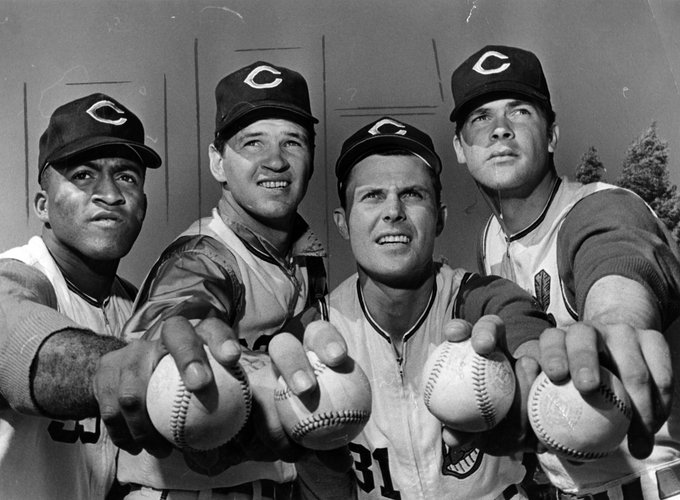
- Category
-
Cleveland Guardians

